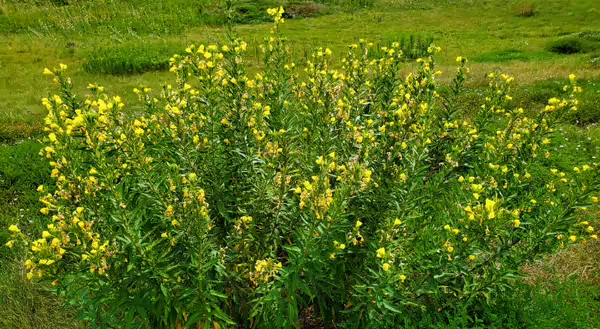
In recent weeks, I have noticed an unfamiliar yellow flower around central Illinois. It seems to be everywhere I go from ditches and roadsides to local natural areas or even around public gardens. With its prevalence along my routine travel paths, such as the I-72 or I-74 corridors, I’d been inadvertently botanizing while driving but unable to reach any conclusion.
Earlier this week, I finally had to stop and take a careful look at a few plants I’ve passed almost daily, near an interstate offramp. Upon closer inspection, I recognized the delicate yellow flowers perched on tall stems with willow-like leaves. It was common evening primrose (Oenothera biennis)! Or was it?
I had to second guess my initial impression due to all the places I’ve noticed this plant. It seemed to be just about everywhere in the last few weeks, and in my mind, I was almost certain that it must be the latest new invasive species. When primrose popped into my head, I began to think twice since I can’t recall ever seeing it so widespread in central Illinois.
It’s certainly possible I could have overlooked this plant in past years, but the pastel yellow flowers really stick out right now. Most of our native species are a much darker yellow, and there’s actually not a lot of things in bloom right now.
The natural world is shifting from the large suite of summer bloomers to a fall display that hasn’t materialized quite yet. This is also another reason why primrose has captured my attention so fervently in recent weeks. I’m usually on the prowl for late summer blooming plants to fill in this annual gap in flowering. Pollinators need ample floral resources all season, and late summer typically is a bit of a drought in my home gardens.
In the end, I did some quick internet research to reassure myself that I was, in fact, looking at Oenothera biennis and concluded that it was, in fact, the plant in question.
An Unusual Lifecycle
The native common evening primrose is a pretty interesting plant. It’s known to occur primarily in disturbed areas, such as ditches and interstate corridors. It also pops up around the edges of prairies and various locations on the edges of natural areas or in forest openings. It tolerates a range of conditions including full sun to nearly full shade, which is why it has the ability to grow in so many locations on the landscape.
Common evening primrose is a biennial, which is an interesting life cycle in and of itself. In the plant’s first year, it grows as a rosette, close to the ground and with an entirely different appearance than it has in year two.
In its second year, it sends up leafy, branched stems that usually have much thinner, more willow-like leaves, becoming up to 8 inches in length. From mid-summer to fall, it produces 4-petaled, pastel yellow flowers that have a mild lemony scent, which mature into seedpods full of tiny brown seeds. At the end of year two, mature plants die, leaving the seeds to be dispersed by wind (or human disturbance, such as mowing).
This plant tends to pop up in disturbed areas and I have most notably found it in newly established landscapes or restoration projects. Over time it drops out as plants mature and die in year two. However, seeds can persist for over 70 years in some cases and often come back upon later soil disturbance.
The Role of Evening Primrose
While I really enjoy the pastel yellow flowers this time of year, I’m not sure this plant has much merit in pollinator gardens, given its biennial lifecycle. It may be better left to natural areas with the hope that future disturbance can prompt the seed bank.
If you were wondering what mysterious, yellow-flowered plant is all over the place right now, the mystery is solved. And it's nice to know this plant is not our next invasive species threat!